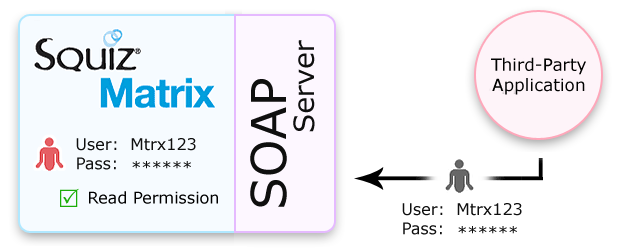SOAP Server
Last Updated: 22 Mar 2016
The SOAP Server asset is used to enable the execution of core-level Squiz Matrix functions over the Simple Object Access Protocol (SOAP), allowing third-party applications to create, modify and retrieve content within the system. These functions are handled by API assets, linked and managed under the SOAP Server, providing a distinct set of Squiz Matrix functionality. For more information on these functions, refer to the SOAP API asset chapters in this manual.
Bookmarks to the headings on this page:
![]()
The Web Services folder
To add a SOAP Server, in the Add menu, go to Web Services -> SOAP Server. For a SOAP Server to work, it must be created under the Web Services folder, as shown in the figure to the right. An enabled SOAP Server should also be Live and have the appropriate permission levels set.
You can configure the settings of the SOAP Server on its associated asset screens. The majority of these screens are the same or similar to those for a Standard Page and are described in the Asset Screens manual. In this chapter we will describe the Details screen, which is different for a SOAP Server.
HTTP Authentication
Squiz Matrix's SOAP Server uses HTTP basic authentication to communicate with external systems. A valid username and password must be specified in order to access the SOAP Server, as shown in the diagram below. Please note that Squiz Matrix users should have Read Access in order to utilise the operations on the SOAP Server.

HTTP Authentication on the SOAP Server
For more information on HTTP authentication, refer to the HTTP Authentication with PHP PHP manual.
Details Screen
The Details screen allows you to select the SOAP API Asset Service assets on the SOAP Server. For more information about the Status, Future Status, Thumbnail and Details sections, refer to the Details Screen chapter in the Asset Screens manual.
API

API Assets
This section allows you to select the APIs that will be available on the SOAP Server and manage the server's WSDL. For the fields in this section to be available, API assets must be created as children of the SOAP Server, as shown in the figure to the right.
The fields available in this section are as follows.
- APIs available to this service: select an API to make it available for use on the SOAP Server. If Enable is selected for an API asset, the functions selected on the API asset's Details screen will be available on the SOAP Server.
- Namespace: define a static namespace to be used in the SOAP Server's response.
- Regenerate WSDL: select this field to regenerate the SOAP Server's WSDL to reflect any new changes made to the server, such as an API asset being enabled. The WSDL for the SOAP Server displays the operation parameters available for the functions enabled on the SOAP Server. The WSDL of a SOAP Server can be viewed by appending ?WSDL to the URL of the server. For example, http://SYSTEM_ROOT_URL/_web_services/soap-server?WSDL.
If you plan to run SOAP functions over a secure connection (https://), you will need to generate the SOAP WSDL file over HTTPS, otherwise the WSDL file will be incompatible with your SOAP function calls.
